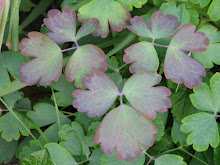One of the pitfalls of bringing my camera outside is that I usually take close to (or more than) one hundred photos at a time, sometimes daily...leaves, insects, webs, a beautiful light pattern, birds, or anything else that catches my eye. This is a danger when my goal is to have a relatively balanced blog, with equal parts knitting/crafting, cooking, and nature. Nature usually wins out in a big way, and I guiltily store my recipe shots for another week, and then another...I
have been knitting, and I
have been cooking, although that isn't always reflected here.
The weather has been beautiful. Sunny, breezy, and mid-70s during the day, and mid-50s at night. Fall is here, and I am spending more time in the kitchen. I recently found a local farmers market and stocked up on good local produce. I used it to make a tasty fall-inspired meal for Todd, and I thought I'd share it quickly before it gets pushed to the back burner indefinitely. With end-of-the-season fruits and vegetables still readily available, this is the perfect time to experiment!
The main course is a buttery galette filled with seasonal vegetables. I took the main recipe from the always-reliable Smitten Kitchen blog and tweaked it a bit to fit our tastes. The good thing about it is that it's easily customizable! This galette has a pie crust base. I recently had an older friend tell me that she's always been afraid to make her own crust. Don't be afraid! It doesn't have to be pretty, and homemade is always better. Smitten Kitchen has a great tutorial
here.
Late Summer Galette
Adapted from
Smitten Kitchen
For the pastry:
1 1/4 cups flour
1/4 teaspoon table salt
8 tablespoons cold unsalted butter
1/4 cup plain yogurt or sour cream
1/4 cup ice water
For the filling:
1 tablespoon olive oil
1/4 teaspoon salt
3 cups cherry or grape tomatoes
1 onion, sliced
6 ounces mushrooms, sliced
8 - 10 basil leaves, sliced
2 cloves of garlic, diced
handful of cheese
a pinch or two of red pepper flakes
Make dough: Whisk together your flour and salt. Dice up your butter and quickly "cut" it into your mixture with a pastry cutter or fork. The bits should be pea-sized. In a separate bowl, stir together your ice water (minus the ice) and sour cream or yogurt. Add this to your flour mixture and toss. You may need to add a bit more liquid to obtain a mass that sticks together when you pat it. Lay out plastic wrap, form a large ball, and secure it in the plastic wrap. Refrigerate for about an hour.
Make filling: Use a skillet with a lid for this one! Take your tomatoes...I found an amazing heirloom variety.
Heat your olive oil and sprinkle in your red pepper flakes. Add your tomatoes and cover. Make sure your burner is on HIGH. Roll them around until the skins split and some of the liquid cooks out.
Once they're cooked down a bit, put them in a bowl to cool off. Using the same skillet, add more olive oil and saute your onions until they're translucent and softened, about 10 minutes. Throw in your mushrooms and cook for another five minutes, until they release their liquid and cook down a bit. Finally, add your diced garlic and sliced basil. Cook for another minute and then pour this mixture on top of your tomatoes, letting it cool.
Now, take that cooled pie crust...
...and roll it into a rough circle. It doesn't have to be fancy! I spread a healthy amount of cheese in the center, and then mixed more cheese in with my vegetables. Spoon it on top of your cheese and spread it out a bit, leaving an inch or so all around. Then fold up the edges.
Place galette in your oven, preheated to 400 degrees. Bake for 30 - 40 minutes, or until the crust is golden brown.
Yum!
It's healthy and bursting with seasonal flavor!
For dessert, I used some late-season peaches to make a simple cobbler. This recipe comes from How Sweet It Is and incorporates browned butter, which adds a rich nutty flavor. Again, don't be afraid to try this technique if it's new to you. Practice makes perfect!
Browned Butter Peach Cobbler
Very slightly adapted from
How Sweet It Is
1 1/2 cups old fashioned oats
3/4 cup flour (I used a mixture of white and whole wheat)
3/4 cup brown sugar
1/4 teaspoon salt
1 teaspoon cinnamon
1/2 teaspoon cardamon
1/2 cup butter (I used a tablespoon or so less to make it a bit healthier)
4 ripe peaches, peeled, de-pitted, and diced
Preheat your oven to 350 and blanch your peaches. Blanching is a simple process that involves quickly boiling them, then putting them in cold water, so that the skin peels off easily. Directions are
here if you want to try it. Or, you could peel them the old-fashioned way if you'd like. Dice the peeled peaches and set aside. In a bowl, mix your dry ingredients together. Brown your butter (directions
here if you've never done it) and let it cool a bit. Add it to the flour/oatmeal mixture, along with the vanilla, and stir until all the liquid is absorbed. Mix your peaches in, and pat the mixture into a greased 8 x 8 pan.
Bake for about 30 minutes and let cool completely. Then you can dish it out!
Hey, it's not pretty, and certainly not fancy, but both dishes got rave reviews from Todd. Although it may seem like a lot of steps, the cobbler only took about 15 minutes to throw together, and the galette (minus the pie dough waiting time) was just about 20 minutes. Paired with a healthy side salad, this is the perfect fall meal...until those apples and pumpkins start coming in! Stay tuned, and have a great week!


































































